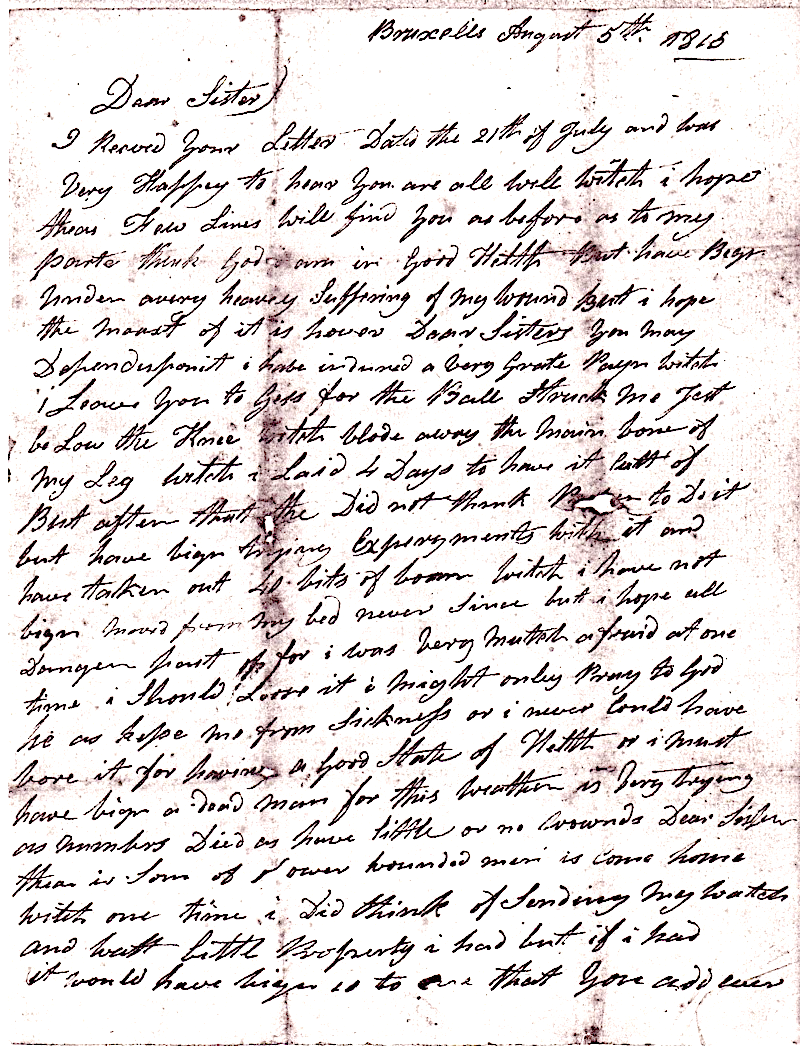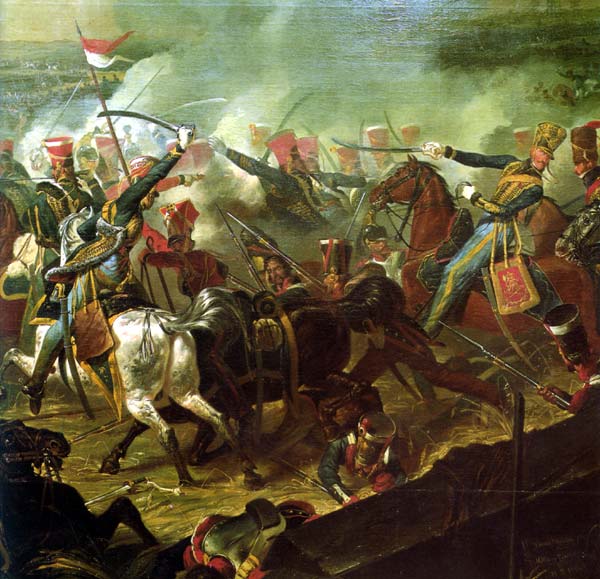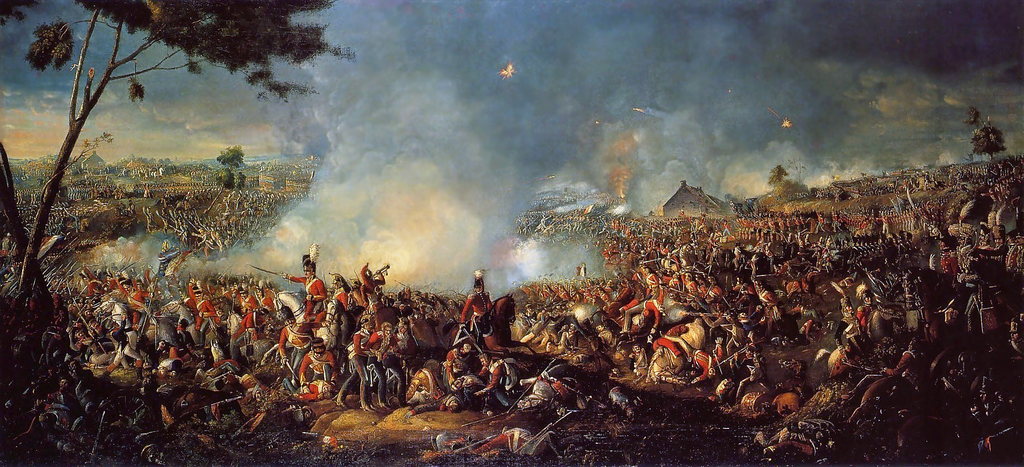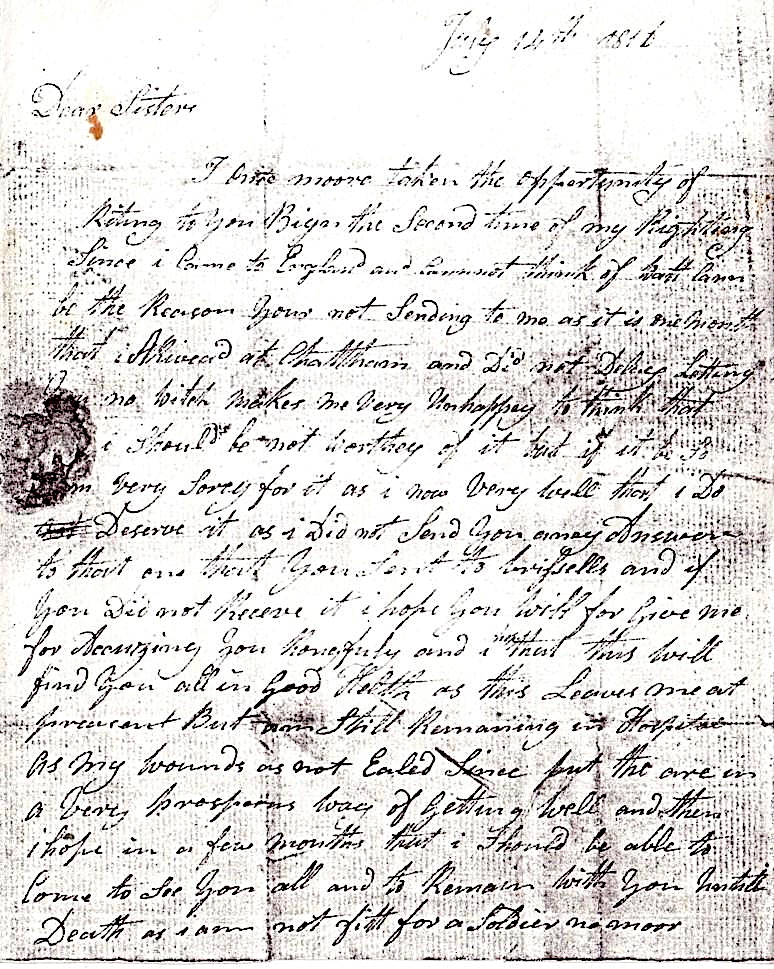Letters from Thomas: A Battle of Waterloo survivor.
The emotional letter, written by a soldier in hospital following the Battle of Waterloo on 18 June 1815, was ragged and well-worn from being passed down through generations. I have extracted the essential messages and adapted them to today’s spelling and writing style.
‘For Mrs Jacobs Near the Half Acre Old Brentford,
England’
Written from Brussels on 5 Aug 1815 to his sister Amy, who had married William Jacobs in 1813, her eldest brother Thomas began by thanking her for her letter of 21st July, and said he was ‘fine’. Then he went on to describe how the ‘ball’ had struck him just below the knee which blew away the main leg bone. He waited for 4 days to have it cut off, but then the doctors decided to experiment and took out 40 pieces of bone. It seems he was then bed-ridden and said that the weather had been extreme and many of his fellow soldiers had died with little or no wounds.
He sent his love to his mother, likewise to his sisters and brothers and to caution his brothers to never think of doing the like that he had done (ie join the Army), but to be content at home. At one time Thomas said he felt that there was no ball made to hit him, of all the battles and skirmishes that he had been in, but then one caught him at last, which had made him an old man and a cripple. Although he ought to be in the bloom of his prime (he was then 29), he wished it would be a warning to his brothers not to follow his example and hoped to be in England in a little while, sending his love to them all. He remained your dutiful brother, Thomas Neville, Serjt in the 15th Corps Hussars.
What led up to the sister receiving that letter?

Letter to his sister Amy dated 5 Aug 1815 from Thomas Neville in Brussels hospital following the Battle of Waterloo.
Thomas was the second child and eldest son born in 1786 to James and Elizabeth Neville. Like his elder sister Mary, Thomas was baptised in the Parish of St. Laurence, Reading on 24 October, prior to his parents moving to Henley-on-Thames within two years, where Amy had been born.

Baptism of Thomas Neville on 24 Oct 1786 at St Laurence church, Reading, Berkshire. Image taken by author at Berkshire Records Office in 2008.
From 1802 both his parents worked at the Military College at Henley-on-Thames, and on 8 March 1805 when 19yrs old, Thomas joined the Army serving with the Duke of Cumberland’s 15th Hussars throughout his Army career.[1] On joining the army his occupation was listed as a labourer and he was 5’ 7½” tall with brown hair, grey eyes and a fresh complexion.[2] In army records his surname was spelt as Newell, and to confuse matters Thomas stated he was born on 3 May 1789. I tried to disprove that this was our Thomas but as well as being the only one baptised in that region who survived, the signature on Army records completely matches that on his letters to his sister (as Neville). Likewise, the injuries he described to the family match the army records injuries that Thomas Newell received.
Some eight years later, the 15th Kings Hussars moved to Spain and fought in battles there between March to June 1813 but by December that year they were stationed in France where they remained until at least March 1814. Thomas was still a Corporal then, but under Captain Hancox he was promoted to Serjeant (sic) by December of that year. The 15th Hussars troop consisted of 482 Privates, 27 Corporals, 6 Trumpeters, 27 Serjeants and 8 Officers.
In 1815, then escaped from Elba where he had been imprisoned, Napoleon was returned to power in March, and resolved to attack the British, Prussian, Belgian and Dutch armies, by marching into Belgium where they were currently camped. On the 29th May 1815 the whole of the British Cavalry assembled under Lieutenant General the Earl of Uxbridge, and were reviewed by the Duke of Wellington and Prince Blucher.

Picture of the British Calvary Charge. Wikipedia. Public Domain
Fierce fighting began with many battles over the following days but the final day’s battle on Sunday 18 June 1815 was deemed the Battle of Waterloo. In common with the rest of the Army, each man including Thomas Newell, received a medal to commemorate the battle fought then, and was allowed to count two years service for that day.[3] Also the battle honour “Waterloo” was granted to the regiment.

Battle of Waterloo 1815 by William Sadler (1782-1839).
The following Regiment Pay Registers of 25 May-24 June 1815 noted Thomas Newell as being ‘Sick at Brufsels’, also in hospital were 5 Serjeants and Corporals plus 31 Privates. Noted as ‘Dead’ in that ledger were 2 Serjeants and 18 Privates, however in all the regiment suffered 5 Officers and 69 men killed and wounded.[4] Those killed included Thomas’ immediate superiors Lieutenants Edward Byam and Sherwood; additionally the regiment lost some 42 horses killed and 52 wounded.
Thomas remained in the Brussels hospital for some seven months before being shipped to Port Pitt hospital at Chatham, Kent. A copy of his letters to his sister Amy Neville (married name Jacobs) written by Thomas follows, and once again I have included extracts of this second letter held by the family. It was a very sad, pleading letter.[5]
‘Mrs Jacobs
near the Half Acre, Old Brentford, Middlesex’
Addressed to ‘Dear Sisters’ on 14 July 1816, it seems Thomas had written after returning to England but not had a response, although he had been in Chatham a month. Not having heard obviously upset him and he apologised for not responding to any letters except for the one sent to Brussels. His wound hadn’t healed, and he was not fit to be a soldier now, and at that point had not had any settlement from the regiment. He asked if his sister Marey (Mary) was married or not and how his mother and brothers were. Pleading for them to write by return of post to Port Pitt Hospital, Chatham, Kent.
Signing the letter ‘your Loving Brother Thomas Nevell Serjt 15th Hussars.

2nd letter from Thomas Neville, written on 14 July 1816 to his sister, Amy while at Port Pitt Hospital, Chatham, Kent.
Thomas was finally discharged on a Pension on 6 March 1817 as a Chelsea Out-Pensioner (ie not living in).[6] His Discharge papers stated he was in His Majesty’s 15th Regt of Hussars under HRH the Duke of Cumberland in Colonel. Thomas Newell Serjeant, born in the Parish of Henley was enlisted at London on 7 March 1805 at 21 years for Unlimited Service. The papers went on to state that he had served for 12 years after the age of eighteen. His Cause of Discharge when he was about 31 Years of Age was in consequence of a gunshot wound in the right knee, received at the Battle of Waterloo.
Lieutenant Colonel Leighton Dalrymple stated Thos Newell has been borne a High Character as a Soldier and Officer and signed the discharge at Nottingham on 6 Day March 1817. Thomas then acknowledged having received all due to him on that same day in 1817 and that he was to receive a pension.
By the tone of his pleading letter to Amy, although awarded an Army pension Thomas obviously had to obtain employment in order to survive, which would have been difficult with his severe leg injuries. Some 11 years later his application to be admitted as a Chelsea In-Pensioner was successfully approved on 18 December 1828 and he was admitted on Christmas Day, a week later. The Admittance Roll noted ‘Particularly recommended’ which leads me to wonder if this is because he was a Battle of Waterloo veteran or did a member of his extended family hold some military or other status?[7]
Unfortunately Thomas’ health had by this time deteriorated and he passed away within 7 months and was buried at the Chelsea Hospital burial ground on 18 July 1829. He is noted as residing in the 3rd Ward at Royal Chelsea Hospital and being 42 years of age, which was his correct age according to his baptism record. [8]
On my trip to England in 2015 I visited this wonderful institution, which is still providing accommodation to Veterans. The burial ground is facing Royal Hospital Road and is very peaceful to walk through, but not surprisingly there is no tombstone marking Thomas’ final resting spot. The Royal Chelsea Hospital has a marvelous Museum, Chapel, Grand Dining Room and gardens which visitors are free to wander through.
Note: Other blogs by Bobbie Edes following the Neville family:
https://gsq-blog.gsq.org.au/the-neville-family-myth-false-true-or-maybe/
https://gsq-blog.gsq.org.au/digging-deeper-into-the-neville-family/
Bibliography:
[1] The National Archives, Kew. Ref: WO25/897
[2] The National Archives, Kew. Ref: WO116/24 & The National Archives, Kew. Ref: WO120/21
[3] The National Archives, Kew. Ref: MINT16/112-27_1 and The National Archives, Kew. Ref: MINT 16/112-27_2. Page 117
[4] https://www.britishbattles.com/?s=waterloo+casualties
[5] My thanks to Alister Neville for sharing the letters with me, the letters remain in the care of his family
[6] The National Archives, Kew. Ref: WO97/100/57
[7] The National Archives, Kew. Ref: WO23/162. In Pensioners Admittance Roll
[8] The National Archives, Kew. Ref: RG4_4331 RG4. England and Wales, Non-Conformist Record Indexes (RG4-8)

Comments
Letters from Thomas: A Battle of Waterloo survivor. — No Comments
HTML tags allowed in your comment: <a href="" title=""> <abbr title=""> <acronym title=""> <b> <blockquote cite=""> <cite> <code> <del datetime=""> <em> <i> <q cite=""> <s> <strike> <strong>